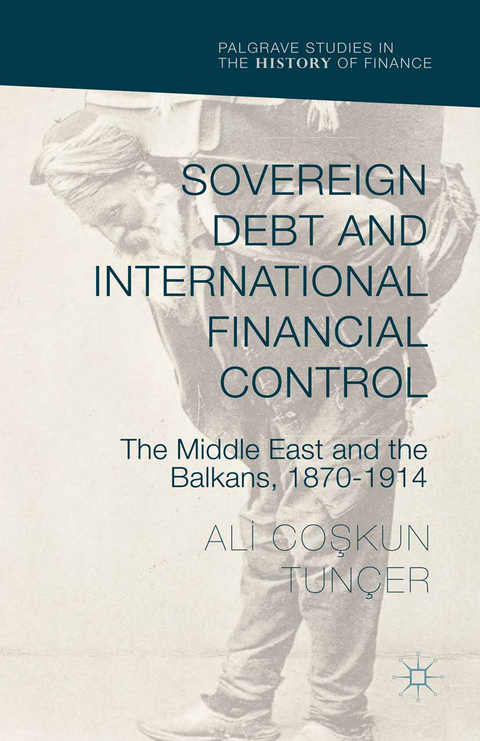
Sovereign Debt and International Financial Control
Palgrave Macmillan (Verlag)
978-1-137-37853-8 (ISBN)
Ali Co?kun Tunçer is Lecturer in Modern Economic History at the Department of History, University College London (UCL). Previously he taught and conducted research in economic history at the London School of Economics and the European University Institute, Italy. His research focuses on the economic and financial history of the late Ottoman Empire, long-term economic change in the Middle East and Southeast Europe, the history of financial markets from the early modern era to the present, and long-term market integration in Europe and the Mediterranean.
1 Introduction
2 Governing Sovereign Debt: Defaults And Enforcement, 1870-1914
2.1 Origins Of Defaults: Financial And Monetary Constraints
2.2 Costs Of Defaults: Enforcement And Conditionality
2.2.1 Direct Sanctions And Preventing Access To Future Credit
2.2.2 Protective Clauses And Bondholder Committees
2.2.3 Assignment And Control Of Future Revenues
2.3 Summary And Conclusions
3 From Financial Control To Colonisation: Egypt, 1862-1914
3.1 Khedives As Borrowers: Crisis, Default And Punishment
3.2 The Loss Of Political Sovereignty And Imperial Rivalry
3.3 Summary And Conclusions
4 From ''Financial Barbarism'' To Cooperation: The Ottoman Empire, 1854-1914
4.1 Lending To The Sick Man Of Bond Markets
4.2 The Loss Of Fiscal Sovereignty And Cooperation
4.3 Summary And Conclusions
5 From Fiscal Control To Financial Supervision: Serbia, 1878-1914
5.1 A Newborn State Surrounded By Foreign Creditors
5.2 Financial Control In A ''LandOf Monopolies''
5.3 Summary And Conclusions
6 From Financial Supervision To Political Resistance: Greece, 1879-1914
6.1 Financial Isolation And Settlement: A History Of Defaults
6.2 Refining The Control And ''Mistrust'' To Creditors
6.3 Summary And Conclusions
7 International Financial Control And Sovereign Risk
7.1 Determinants Of Sovereign Risk Before 1914: A Critical Review
7.2 Measuring Sovereign Risk: Sources And Methodology
7.3 Structural Breaks In Spread: The Bai-Perron Test
7.4 Summary And Conclusions
8 Debt, Default And Resistance: Political Economy Of Ifcs
8.1 Fiscal Capacity, Political Regimes And Tax Systems: A Review
8.1.1 Taxation Vs Representation
8.1.2 Direct Vs Indirect Taxes
8.1.3 Political Regime Type And Public Debt
8.1.4 Foreign Rule: Resistance Vs Cooperation
8.1.5 Conclusion
8.2 Varying Degrees Of Success And The Extent Of Control
8.3 Political Institutions And Tax Systems In The Middle East And The Balkans
8.4 Summary And Conclusions
9 Conclusion
Bibliography
Data Appendix
| Erscheint lt. Verlag | 26.8.2015 |
|---|---|
| Reihe/Serie | Palgrave Studies in the History of Finance |
| Zusatzinfo | XVII, 243 p. |
| Verlagsort | Basingstoke |
| Sprache | englisch |
| Maße | 140 x 216 mm |
| Themenwelt | Geisteswissenschaften ► Geschichte ► Regional- / Ländergeschichte |
| Geschichte ► Teilgebiete der Geschichte ► Wirtschaftsgeschichte | |
| Naturwissenschaften | |
| Sozialwissenschaften ► Politik / Verwaltung ► Staat / Verwaltung | |
| Wirtschaft ► Allgemeines / Lexika | |
| Wirtschaft ► Betriebswirtschaft / Management ► Finanzierung | |
| Wirtschaft ► Volkswirtschaftslehre ► Finanzwissenschaft | |
| Wirtschaft ► Volkswirtschaftslehre ► Makroökonomie | |
| Wirtschaft ► Volkswirtschaftslehre ► Wirtschaftspolitik | |
| ISBN-10 | 1-137-37853-0 / 1137378530 |
| ISBN-13 | 978-1-137-37853-8 / 9781137378538 |
| Zustand | Neuware |
| Haben Sie eine Frage zum Produkt? |
aus dem Bereich


